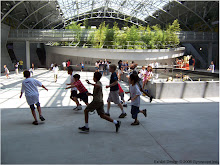Creating opportunities for visitor participation is an emerging trend in the museum-field overall. There are many reasons for this: it is aligned with visitor expectations, it helps museums develop relationships, and it doesn’t have to cost a lot of money. So we were curious, how many children’s museums are finding ways to hear from their audience how is that happening, and what happens to visitor input once the museum has it?
What we learned is that just over half (23 of 42) of the children’s museums in our survey solicit visitor feedback. This is largely done through talk back stations (10) and post-it boards (14).
Some museums (10) incorporate visitor-written labels, and more (20) have a way for visitors to leave projects in the museum for other visitors to encounter and interact with.
This last type of visitor participation means that in some portion of these museums, visitor creations are incorporated into the galleries. That could be through hanging of wet paintings - as at the Denver Children's Museum, where the drying artwork creates an inspiring backdrop for new visitors - or as an changing environmental installation - as in Maker Kids at the Austin Children's Museum where throwems enlivened a dark tunnel.
So participation is happening, and children's museum seem to be experimenting with how to do it. And I realize that there are many reasons – historical and operational – why museums do not create more participatory models for exhibitions. And yet, this is not a new idea.
Some Examples

Going back to 1999, Gyroscope designed a temporary exhibit for the Museum of Science, Boston and the Museum of Fine Arts called Virtual Egypt. In it, we featured an artifact that had yet to be identified by archeologists. There were theories about what it was, including a section of a book with illustrations that appeared to be of the same object. But no one could say for certain. We presented the evidence to visitors and invited them to submit their hypotheses to be offered alongside those of the experts. Visitors became a part of the ongoing scientific dialogue and debate – a real one.
Go Big or Go Home
From outside the museum field, there have been some really significant experiments in the idea of co-created, not just participatory, experiences. I am talking about community-built playgrounds. Here, the community literally has loose parts and reconfigures them into playspaces. The parts are essentially a platform, or a series of affordances. The making of the space is a learning experience. This reminds me of a visitor experience master plan we once created for a museum that was all about kids reinventing the exhibit environment.
On Line
I have to mention the Frist which has a muse award winning website where visitors can upload digital pictures of the artworks they make in the museum, and then comment on them. Although the website was created through an IMLS grant which is about adult English language learners, the audience of 6,000 which currently maintain on-line portfolios includes many types of visitors, and creates a genuinely visitor-centered way for their audience to participate. I would love to see digital art in the museum curated from the on-line portfolio, to complete the circle and make it so that visitors could see themselves in the museum during their visit (the Frist could easily find out who is in the museum since all portfolio users have a unique ID card).
That kind of circling back between the web and the museum is what the Science Museum of Minnesota has been exploring through Sciencebuzz – although their visitor-participation is focused on learning visitor preferences for content themes and exhibit emphasis, rather than on co-creation.
What does Participatory mean?
But when we talk about participation we often talk about a very limited role for visitors. Not truly co-creating exhibitions and making knowledge through the making of things and of spaces. We usually talk about talk-back boards, as evidenced by the survey results. And when we talk about visitors making thing for the exhibits we usually mean temporary elements for looking at, or listening to, rather than for building onto collectively and incrementally over time.
For museums, the power of participation lies in the ability to customize experiences and extend visitors learning - leading to many more points of entry into the museum experience and a more durable relationship with visitors. For visitors, participation leads to many benefits including increased relevance and meaningfulness, improved understanding of oneself, and the chance to co-create knowledge. For both the organization and the visitor this process also establishes a dialogue, giving visitors an opportunity to take charge of their inquiry and providing valuable insight into the audience’s interests and concerns.












